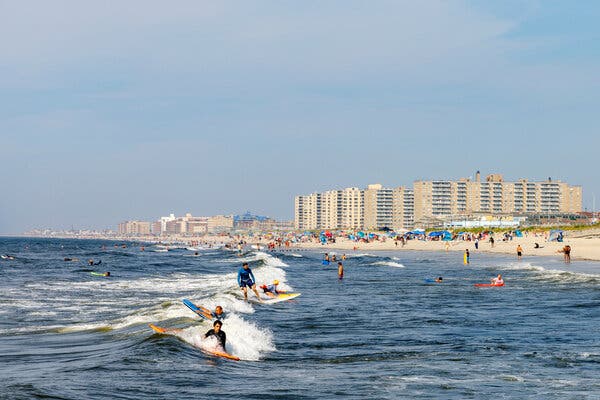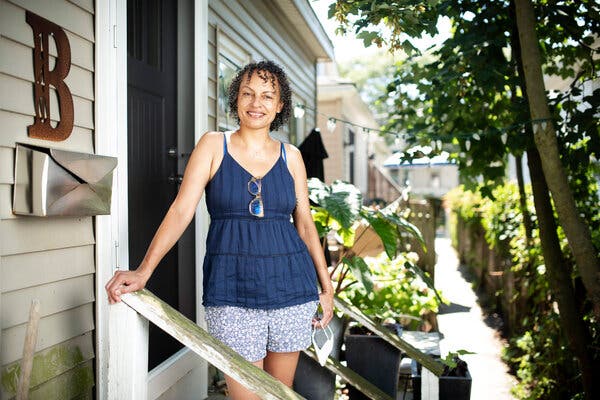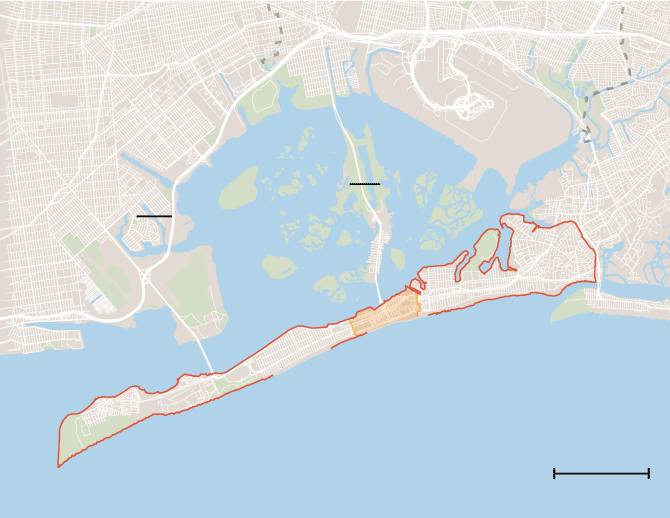Advertisement
Domestic Lives
Rockaway Beach has a land’s-end bacchanalian spirit, but it is also a place where you can get to know people just by being there.
15 Photos
View Slide Show ›

Stefano Ukmar for The New York Times
The first morning that I woke up in Rockaway Beach after moving from Brooklyn eight years ago, I walked barefoot with my coffee to the boardwalk just because I could. It was April and my feet were stinging from the cold by the time I got there, but the smell of salt air, the warmth of the sun and the sight of cormorants diving for fish in the slate blue waves more than made up for it.
“I can’t believe I really get to live here,” I remember thinking.
At the time, I was still reconstructing myself after a divorce and had thought the Rockaways, which stretch beneath the southern edges of Brooklyn and Queens, were too far away from my job in Midtown as a reporter at The New York Times and my regular haunts in Lower Manhattan and Brooklyn to live there full time. But as I found myself making frequent pilgrimages on the A-train in a hapless, middle-aged quest to learn to surf, the idea of having an urban beach life took hold.
It was a kind of carefree idyll I was after, a way to escape the pressures and strictures of my workaday life without giving it up — I had a career and a mortgage to sustain. But, after almost a decade of living in Rockaway — and experiencing two disasters, first Hurricane Sandy and now coronavirus — I realize I ended up with something even more important: membership in a real community I hadn’t realized I was looking for.

In my search for a beach home, I considered a few options — a bungalow in Far Rockaway where the eastern end of the peninsula hits Nassau County; a boxy two-family house a few doors down from a friend’s; a clean, modern oceanfront condo across from the main surf break — but none quite fit my finances. Determined to put down roots, though, I reached out to an agent I’d met.

QUEENS
NEW YorK
Jamaica
Bay
Wildlife
Refuge
BROOKLYN
nassau
BELT pkwy.
JAMAICA
BAY
ROCKAWAY BEACH
ROCKAWAY
PENINSULA
ATLANTIC OCEAN
2 miles
It was late 2011 and sales activity was still nowhere near where it had been during the bubble that preceded the financial crisis. In 2009, for instance, the Rockaways logged 617 home sales with an average value of $425,259, according to data compiled by Jonathan Miller, president of the appraisal firm Miller Samuel. Activity fell over the next two years, reaching 433 sales with an average value of $366,870 in 2010 and 360 sales with an average value of $405,904 the year after.
There wasn’t much on the market, but the agent showed me a place I fell for on the spot: a two-story Dutch Colonial Revival built in 1913 as a summer cottage that was listed for $265,000. Not even 650 square feet in all, it was tucked away on an alley that ran in from the sidewalk a half block from the ocean and abutted a community garden.
I was captivated by its location, architecture and old-school quirks, like its gambrel roof and the unmilled tree trunks in the basement that had once propped up the building. But I was also smitten with the way of life it embodied, one that dated back to some of the earliest New Yorkers.
Long before European colonists arrived, the Rockaway peninsula was already a summer destination: the Lenape people who populated the area would spend the warm months at the beach fishing and gathering oysters before moving inland for fall and winter.
The peninsula eventually grew to become the city’s premier resort, attracting Gilded Age high society like Astors and Vanderbilts, literati like Henry Wadsworth Longfellow, Washington Irving and Walt Whitman, and regular folk looking for relief from the sweltering city. At its height, millions of visitors thronged to the bathhouses and honky-tonk establishments that lined the boardwalk and to the amusements that stretched from the ocean to Jamaica Bay.
Those days are long gone, but that land’s-end bacchanalian spirit still pervades the place, especially in summer when the crowds of raucous day-trippers arrive — DFDs, those down-for-the-day, as they’re known. Over the years, I’ve learned to stock up and hide out at home with my boyfriend on weekends, not venturing out for a meal on the boardwalk until Monday — T.G.I.M. we always say.
Even this year, and especially since swimmers have been allowed back into the water, the influx of excited young people, many decked out in colorful and revealing beachwear, has transformed the boardwalk — where the concessions have opened — into a kaleidoscope of bare chests and bottoms, tattoos, piercings and hair dyed all manner of colors.
As a year-rounder, I found it wasn’t so difficult to penetrate the social scene — Rockaway is a place where you can get to know people just by being there. I made friends at first with my neighbors and the other regulars on the boardwalk checking out the waves at sunrise. Later, I’d come to know people from the water, where surfers would offer me advice in the waves and invitations to parties on land.
I saw that same generosity after Sandy, when surfers from all over showed up in Rockaway with shovels to help dig out basements — including mine, which had been completely submerged — and clear rubble from the flood. And I’ve seen it since, in the regular beach cleanups, mutual pandemic aid networks and still-too-frequent rescues of swimmers drowning in our treacherous waters.
I’ve also come to anticipate the seasonal rhythms of a part of the city that’s particularly vulnerable to weather. Spring and summer bring not only lush greenery and flowers to neighborhood streets and yards, and vegetables to plots in the community gardens, but also new inhabitants to the marine wilderness surrounding the peninsula.
I still marvel at the giant osprey nests and flocks of egrets and multicolored ducks along the waterways of the Jamaica Bay Wildlife Refuge. On the Atlantic side, it’s seals resting in the sand, dolphins playing in the waves, seabirds divebombing the ocean and humpback whales erupting from the surface.
Fall often brings the big, powerful swells surfers more adept than I look forward to all year, the product of hurricane-season storms. I can’t see the water from my house, but I can smell and hear it on those days as the waves heave up off the sandbars and rumble onto the shore, the briny scent of their spray wafting down my block.
The whole neighborhood seems to crackle with excitement. Streets fill with surfers running toward the ocean, boards under their arms. Local hangouts ring with amped-up chatter about waves made or lost — “Dude, did you see that barrel? It was sick!” — or what the delicate interplay of pressure systems, wind, tides and daylight will bring the next day.
Winter, at least when I first arrived, brought a raw peacefulness with the summer visitors gone, wind sweeping sand off the beach and the ocean turning a foreboding charcoal gray. Long commutes on the A train in darkness also heightened the sense of isolation from the convenience and bustle of more heavily populated districts closer to the center of the city.
But even that’s changed in the years since Sandy, as dilapidated buildings and derelict lots give way to new homes and apartment buildings and evermore year-round establishments. Luxury condo buildings are springing up on Beach 116th Street, a commercial corridor in Rockaway Park, spurring new food offerings and an Orangetheory Fitness. On Beach 108th Street near the shore, the Rockaway Hotel, a boutique outfit complete with pool, rooftop bar and spa, is planning to open in August, with rooms starting at $300 a night.
The Arverne by the Sea project, part of a vast urban renewal area designated in the 1960s, is nearing the final phases of development, bringing dozens of new apartments and businesses — a wine shop, an espresso bar, a cafe and a well-regarded barbecue joint — to an already burgeoning area.
There’s a new eco-friendly affordable housing complex in Edgemere designed to meet passive house standards for energy efficiency and with features to help withstand flooding and storm damage. And a nearly $300 million redevelopment plan for downtown Far Rockaway is underway. Though home sales activity has never rebounded to its 2009 height, values have generally been on the rise in recent years, with 509 sales in 2019 at an average price of $536,668.
Even so, Rockaway Beach still feels like a small town — the kind of neighborhood where you look around when the door of the bar or restaurant opens because it might be someone you know. Many of those places are operated by people who live in or have a longstanding connection to the area, and they have scrambled to stay open while adjusting to evolving Covid-19 regulations. That, along with the relatively low population density and open shoreline, has made Rockaway Beach a less difficult place to weather the pandemic than some others.
“I wish I was a teenager now in Rockaway because there’s things to do,” said Rashida Voorhies, a co-owner of Sayra’s Wine Bar, who grew up in the neighborhood at a time when she said there wasn’t much activity beyond sitting on the beach jetty or playing in the sand.
“You can actually hang out in your community — you don’t have to get on the train or the bus,” she said. “I heard a customer say, ‘I don’t leave Rockaway on the weekend.’ Usually, it was the other way around.”
Diane Cardwell is the author of “Rockaway: Surfing Headlong into a New Life.”
For weekly email updates on residential real estate news, sign up here. Follow us on Twitter: @nytrealestate.






Recent Comments